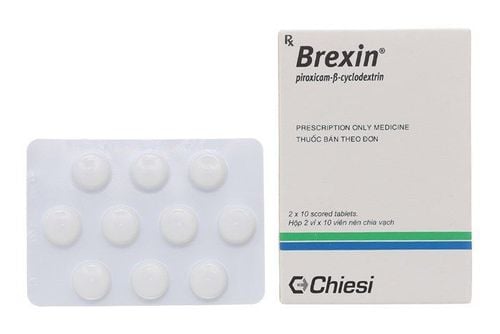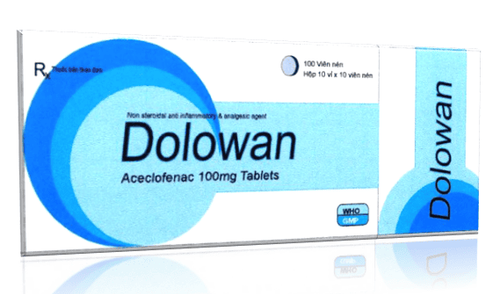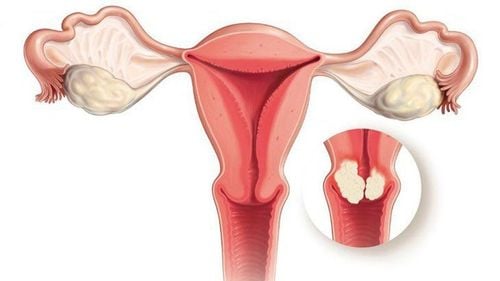This is an automatically translated article.
Diclofenac is a pain reliever, anti-inflammatory in the group of non-steroidal anti-inflammatory drugs (NSAIDs). The mechanism of action of the drug is to inhibit cyclooxygenase and reduce the synthesis of mediators of the inflammatory process. Follow the article below to know what is the dose, contraindications and notes when using Diclofenac?1. What is Diclofenac 50?
Diclofenac is a non-steroidal anti-inflammatory drug. The drug has anti-inflammatory and pain-relieving effects. Diclofenac's mechanism of action is to inhibit the activity of Cyclooxygenase, thereby significantly reducing the formation of prostaglandins, prostacyclin and thromboxane - mediators of the inflammatory process. Diclofenac also regulates the lipoxygenase pathway and platelet aggregation.2. Uses of Diclofenac 50
Diclofenac 50 is indicated in the following cases:
Long-term treatment of symptoms in chronic arthritis, osteoarthritis, polyarthritis and spondylitis,... Short-term treatment in cases of acute painful inflammation such as bursitis, dysmenorrhea and pain after trauma or surgery,...
3. Contraindications of Diclofenac 50
Diclofenac 50 is contraindicated for use in humans:
Hypersensitivity to Diclofenac, aspirin or other non-steroidal anti-inflammatory drugs. Asthma, rhinitis and urticaria following aspirin use. Gastric ulcers . Bronchospasm, cardiovascular disease, hemorrhage, severe renal or hepatic failure. Are taking coumarin anticoagulants. Congestive heart failure, hypovolemia due to diuretics or renal failure. Have a glomerular filtration rate < 30 ml/min due to the risk of developing renal failure. Have colloid disease due to the risk of developing aseptic meningitis.
4. Dosage of Diclofenac 50
The dose of Diclofenac 50 must be adjusted with caution, depending on individual needs and responses. The following is a reference dose of Diclofenac 50 in some diseases:
Ankylosing spondylitis: Recommended oral dose of 100 - 125mg/day, divided into several times (25mg x 4 times/day, 25mg can be added once in a day) at bedtime if necessary). Osteoarthritis: The recommended dose is 50mg x 2-3 times/day, or 75mg x 2 times/day. In case of long-term treatment, the maximum dose is 100mg/day. Rheumatoid arthritis: The recommended dose is 50mg, 3 or 4 times a day, or 75mg, 2 times a day. Maximum total dose 200mg/day. In case of long-term treatment of rheumatoid arthritis: The recommended dose is 100mg/day and if necessary it can be increased to 200mg/day in 2 divided doses. Juvenile polymyalgia rheumatica: The recommended dose in children 1 to 12 years of age is 1-3 mg/kg/day, divided into 2 to 3 times. Acute pain or primary dysmenorrhea: Take 50mg, 3 times a day. Recurrent pain, recurrent dysmenorrhea: Initial dose is 100mg, then 50mg, 3 times daily. The maximum daily dose is 200mg on the first day, then 150mg/day on the following days
5. Diclofenac 50 . side effects
Patients using Diclofenac 50 may experience the following undesirable effects:
Common:
Body as a whole: Headache, restlessness. Gastrointestinal: Epigastric pain, nausea, vomiting, diarrhea, bloating and dyspepsia. Liver: Increased serum transaminases. Ears: Tinnitus. Uncommon:
Systemic: Edema, rhinitis, urticaria, allergies, bronchospasm in asthmatics, anaphylaxis including hypotension. Gastrointestinal: Abdominal pain, gastrointestinal bleeding, ulceration progression, vomiting blood, hematuria, local irritation when the drug is administered rectally. Nervous system: Drowsiness, drowsiness, anxiety, depression, irritability and excitability. Eyes: Blurred vision, eye pain, double vision and visual dark spots. Neuromuscular: Back pain, limb pain and musculoskeletal pain. Urinary: Hematuria, cystitis, renal failure, interstitial nephritis and nephrotic syndrome. Other: Increased creatinine, prolonged bleeding time. Rare:
Systemic: Edema, rash, alopecia and Stevens - Johnson syndrome. Nervous system: Aseptic meningitis. Cardiovascular: Arrhythmia, heart failure, flushing, hypotension and palpitations. Dermatology: Alopecia, erythema, exfoliative dermatitis and photosensitivity Endocrine and metabolic: Hyperglycemia and weight changes Blood: Leukopenia, thrombocytopenia, eosinophilia, decreased granulocytosis and anemia. Hepatic: Gallbladder contractility disorder, abnormal liver function tests, hepatotoxicity causing jaundice and hepatitis.
6. Notes when using Diclofenac 50
Central Nervous System Effects: Diclofenac 50 may cause drowsiness, dizziness, blurred vision and other neurological effects. Thus impairing the patient's physical or mental capabilities. Patients must be warned when performing tasks that require mental alertness such as operating machinery or driving a vehicle. Discontinue use of Diclofenac if blurred or decreased vision occurs and have an ophthalmological examination. Periodically evaluate visual acuity in all patients receiving long-term treatment with Diclofenac. Drug reactions with eosinophilia and potentially serious and sometimes fatal systemic symptoms have been reported with the use of NSAIDs. It is recommended to monitor for signs such as fever, rash, lymphadenopathy, and eosinophilia during use of Diclofenac. Non-steroidal anti-inflammatory drugs may increase the risk of inflammation, ulceration, bleeding, and perforation. severe gastrointestinal disease, especially in elderly patients, patients with a history of peptic ulcer disease and/or gastrointestinal bleeding. Therefore, the use of Diclofenac 50 should be avoided in patients with active gastrointestinal bleeding. The lowest effective dose of Diclofenac for the shortest duration, consistent with individual patient goals, should be used to reduce the risk of gastrointestinal adverse events. Hepatic Effects: Increased transaminases have been reported with the use of Diclofenac. In addition, rare, sometimes fatal, serious liver reactions (fulminant hepatitis, hepatic necrosis, liver failure) have occurred with the use of the drug. Therefore, it is necessary to monitor liver function while taking the drug, stopping immediately if clinical signs of liver disease appear. Renal Effects: Avoid use of Diclofenac in patients with advanced renal disease. Discontinue use when abnormal renal function tests persist or worsen. Hyperkalemia may occur, particularly in the elderly, in patients with diabetes mellitus, with renal disease, and with the concomitant use of other drugs with the potential to cause hyperkalemia. Potassium should be closely monitored while taking the drug. Pregnancy: Diclofenac should be used during pregnancy only when clearly needed. Should only be used at the lowest effective dose and for the shortest time. Diclofenac should not be used during the third trimester of pregnancy because of the risk of inhibition of uterine contractions, premature closure of the ductus arteriosus, and renal failure in the fetus. Lactation: The manufacturer recommends that the decision to breast-feed during treatment weigh the risks and benefits. Diclofenac should be avoided in the mother if the nursing infant has platelet dysfunction, thrombocytopenia, or ductal-dependent heart damage.
7. Drug Interactions of Diclofenac 50
Drug interactions can have many clinical consequences such as altering the therapeutic effect or increasing the toxicity of the drug. It is best for the patient to inform the doctor of all prescription and non-prescription drugs and supplements they are taking so that the doctor can adjust accordingly. The following are some drug interactions of Diclofenac 50 to note during use:
Diclofenac should not be used in combination with oral anticoagulants and heparin due to the increased risk of major bleeding. Diclofenac and other non-steroidal anti-inflammatory drugs may potentiate the CNS effects of quinolones, induce convulsions. Aspirin or glucocorticoids may decrease diclofenac plasma concentrations and increase the risk of injury. gastrointestinal injury. Concomitant administration of diflunisal with diclofenac may increase plasma concentrations of diclofenac, decrease clearance of diclofenac and increase the risk of major gastrointestinal bleeding. Diclofenac may increase serum lithium concentrations to toxic levels. If concurrent use is required, the patient should be carefully monitored to detect early signs of lithium toxicity. Diclofenac may increase serum digoxin concentrations and prolong the elimination half-life of digoxin. Therefore, blood levels of digoxin should be measured and digoxin dose reduced if both drugs are used concurrently. Antacids can reduce gastrointestinal irritation caused by Diclofenac but decrease Diclofenac serum concentrations. The article has provided information on dosage, contraindications and notes in the process of using Diclofenac 50. To ensure optimal effect and prevent side effects, patients should refer to this article. Consult your doctor or pharmacist before use.
Please dial HOTLINE for more information or register for an appointment HERE. Download MyVinmec app to make appointments faster and to manage your bookings easily.













